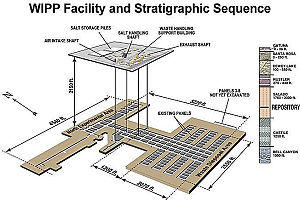Radiation risksDOE chief to visit WIPP to discuss funding for recovery efforts
Energy Secretary Ernest Moniz will visit Carlsbad, New Mexico on 12 August to discuss funding for the Waste Isolation Pilot Plant (WIPP) recovery efforts.Traces of americium and plutonium were released from a nuclear waste drum on 14 February and were detected in the air almost a half-mile outside WIPP. On 15 May, the DOE confirmed that the damage occurred on a waste drum from Los Alamos National Laboratory.

DOE to visit and evaluate WIPP // Source: commons.wikimedia.org
Energy Secretary Ernest Moniz will visit Carlsbad, New Mexico on 12 August to discuss funding for the Waste Isolation Pilot Plant (WIPP) recovery efforts. John Heaton, chairman of the Carlsbad Nuclear Task Force and a former Democratic state senator who helped bring WIPP to New Mexico, has asked Moniz to sit down with Carlsbad city and Eddy County officials to address the recent exposure of toxins. Moniz will be hosted by the New Mexico congressional delegation of Senators Tom Udall (D) and Martin Heinrich (D), and Representative Steve Pearce (R). All three elected officials had asked Moniz to visit WIPP in February, when a truck fire and radiation leak occurred. WIPP, opened in 1999, disposes transuranic waste into a Permian-age salt formation 2,150 feet below ground.
Heaton recently criticized the Energy Department (DOE) for lacking transparency in the recovery and cleanup process, specifically how the agency plans to clean up the compromised waste drum and its storage room. “This is a government operation and you would expect that everything would be completely open and transparent to the public,” Heaton said. “I think that we’ve been guaranteed transparency by the DOE headquarters, but what’s so private about a recovery plan that it can’t be published at this point?”
The Current Argus reports that traces of americium and plutonium were released from a nuclear waste drum on 14 February and were detected in the air almost a half-mile outside WIPP. On 15 May, the DOE confirmed that the damage occurred on a waste drum from Los Alamos National Laboratory. “It’s rather remarkable to take that long, and if every step in this process is going to take that much time, I don’t know how long that will be,” Heaton said. “I guess they were planning every entry in intricate detail, but they were going down (once) every week or two weeks, not every day. I’m sure there was plenty of planning that needed to occur during each trip (but) why did it take so much time to confirm the recovery plan?”
WIPP has not accepted any nuclear waste since the 5 February underground truck fire. The Senate and House appropriations subcommittees drafted legislation in June that would provide emergency funding to the recovery efforts for fiscal 2015. The Senate bill included $102 million for the emergency, in addition to $220 millions previously authorized for normal operations. The House bill offers up to $120 million for recovery efforts contingent upon any excess money that the government had saved from anticipated overpayments of employee pensions.
